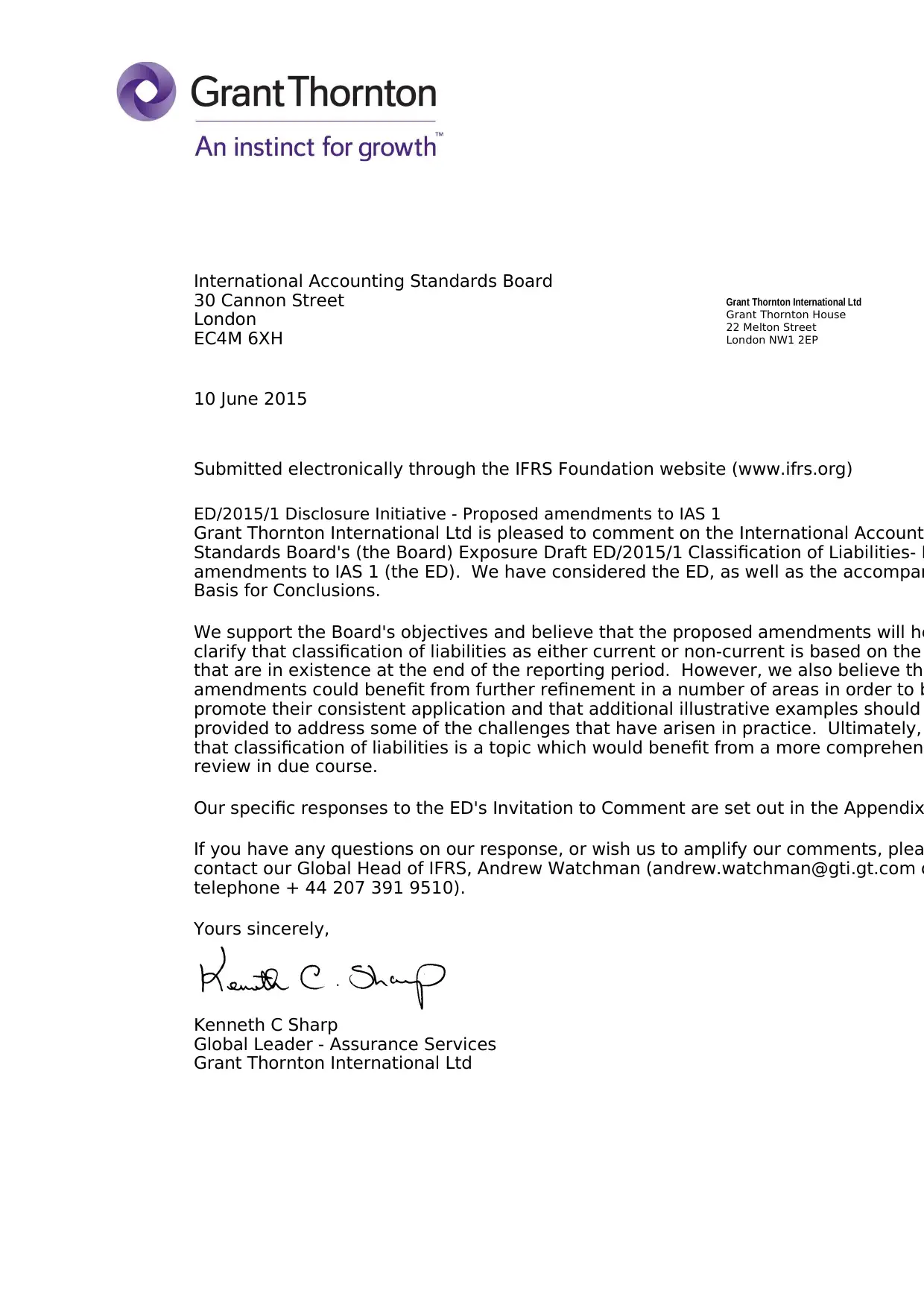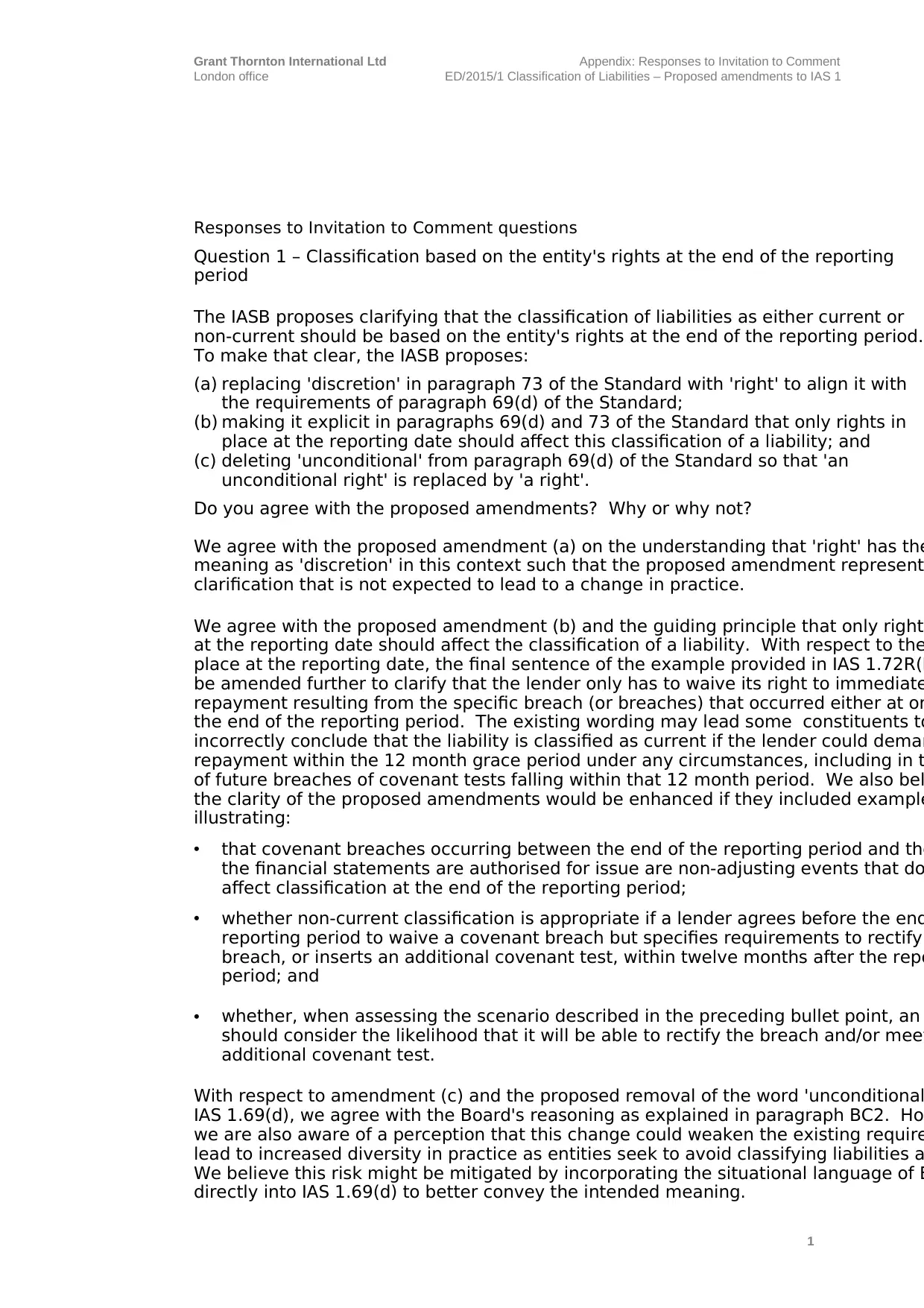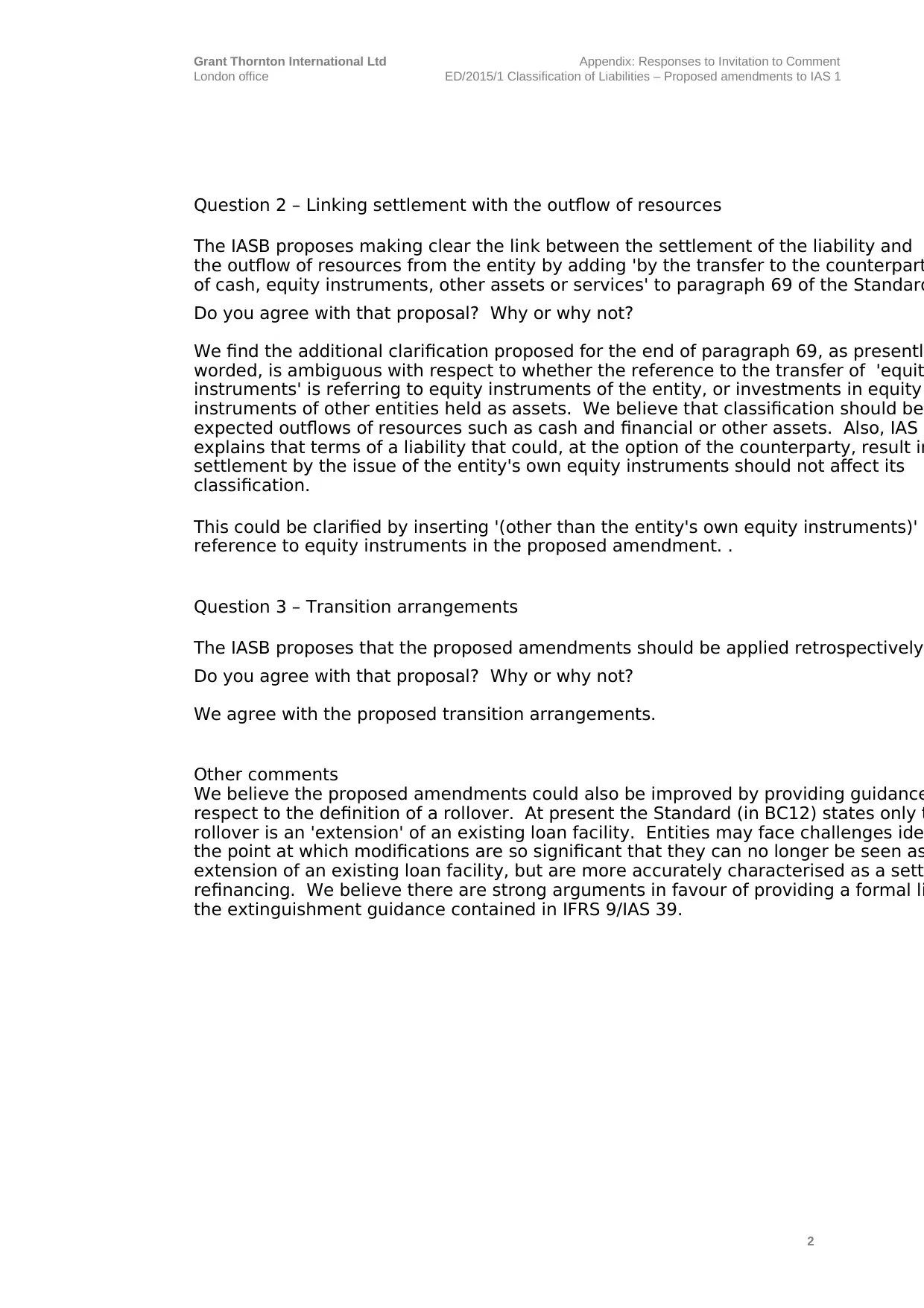Detailed Analysis of Grant Thornton's Response to IAS 1 Amendments
VerifiedAdded on 2023/03/17
|3
|1283
|58
Report
AI Summary
This document is a detailed response from Grant Thornton International Ltd to the International Accounting Standards Board's (IASB) Exposure Draft ED/2015/1, which proposed amendments to IAS 1 regarding the classification of liabilities. Grant Thornton expresses overall support for the Board's objectives, emphasizing the clarification of liability classification based on rights at the end of the reporting period. The response addresses specific questions from the IASB's Invitation to Comment, including the classification based on the entity's rights, linking settlement with the outflow of resources, and transition arrangements. Grant Thornton offers suggestions for further refinement, including examples to clarify the application of the amendments and the definition of a rollover. The response also discusses the implications of removing the word 'unconditional' from IAS 1.69(d). Overall, Grant Thornton's response provides a thorough analysis of the proposed amendments and suggests areas for improvement to promote consistent application and clarity in financial reporting.

International Accounting Standards Board
30 Cannon Street
London
EC4M 6XH
10 June 2015
Submitted electronically through the IFRS Foundation website (www.ifrs.org)
ED/2015/1 Disclosure Initiative - Proposed amendments to IAS 1
Grant Thornton International Ltd is pleased to comment on the International Account
Standards Board's (the Board) Exposure Draft ED/2015/1 Classification of Liabilities- P
amendments to IAS 1 (the ED). We have considered the ED, as well as the accompan
Basis for Conclusions.
We support the Board's objectives and believe that the proposed amendments will he
clarify that classification of liabilities as either current or non-current is based on the
that are in existence at the end of the reporting period. However, we also believe the
amendments could benefit from further refinement in a number of areas in order to b
promote their consistent application and that additional illustrative examples should
provided to address some of the challenges that have arisen in practice. Ultimately,
that classification of liabilities is a topic which would benefit from a more comprehens
review in due course.
Our specific responses to the ED's Invitation to Comment are set out in the Appendix
If you have any questions on our response, or wish us to amplify our comments, plea
contact our Global Head of IFRS, Andrew Watchman (andrew.watchman@gti.gt.com o
telephone + 44 207 391 9510).
Yours sincerely,
Kenneth C Sharp
Global Leader - Assurance Services
Grant Thornton International Ltd
Grant Thornton International Ltd
Grant Thornton House
22 Melton Street
London NW1 2EP
30 Cannon Street
London
EC4M 6XH
10 June 2015
Submitted electronically through the IFRS Foundation website (www.ifrs.org)
ED/2015/1 Disclosure Initiative - Proposed amendments to IAS 1
Grant Thornton International Ltd is pleased to comment on the International Account
Standards Board's (the Board) Exposure Draft ED/2015/1 Classification of Liabilities- P
amendments to IAS 1 (the ED). We have considered the ED, as well as the accompan
Basis for Conclusions.
We support the Board's objectives and believe that the proposed amendments will he
clarify that classification of liabilities as either current or non-current is based on the
that are in existence at the end of the reporting period. However, we also believe the
amendments could benefit from further refinement in a number of areas in order to b
promote their consistent application and that additional illustrative examples should
provided to address some of the challenges that have arisen in practice. Ultimately,
that classification of liabilities is a topic which would benefit from a more comprehens
review in due course.
Our specific responses to the ED's Invitation to Comment are set out in the Appendix
If you have any questions on our response, or wish us to amplify our comments, plea
contact our Global Head of IFRS, Andrew Watchman (andrew.watchman@gti.gt.com o
telephone + 44 207 391 9510).
Yours sincerely,
Kenneth C Sharp
Global Leader - Assurance Services
Grant Thornton International Ltd
Grant Thornton International Ltd
Grant Thornton House
22 Melton Street
London NW1 2EP
Paraphrase This Document
Need a fresh take? Get an instant paraphrase of this document with our AI Paraphraser

Grant Thornton International Ltd Appendix: Responses to Invitation to Comment
London office ED/2015/1 Classification of Liabilities – Proposed amendments to IAS 1
1
Responses to Invitation to Comment questions
Question 1 – Classification based on the entity's rights at the end of the reporting
period
The IASB proposes clarifying that the classification of liabilities as either current or
non-current should be based on the entity's rights at the end of the reporting period.
To make that clear, the IASB proposes:
(a) replacing 'discretion' in paragraph 73 of the Standard with 'right' to align it with
the requirements of paragraph 69(d) of the Standard;
(b) making it explicit in paragraphs 69(d) and 73 of the Standard that only rights in
place at the reporting date should affect this classification of a liability; and
(c) deleting 'unconditional' from paragraph 69(d) of the Standard so that 'an
unconditional right' is replaced by 'a right'.
Do you agree with the proposed amendments? Why or why not?
We agree with the proposed amendment (a) on the understanding that 'right' has the
meaning as 'discretion' in this context such that the proposed amendment represent
clarification that is not expected to lead to a change in practice.
We agree with the proposed amendment (b) and the guiding principle that only right
at the reporting date should affect the classification of a liability. With respect to the
place at the reporting date, the final sentence of the example provided in IAS 1.72R(b
be amended further to clarify that the lender only has to waive its right to immediate
repayment resulting from the specific breach (or breaches) that occurred either at or
the end of the reporting period. The existing wording may lead some constituents to
incorrectly conclude that the liability is classified as current if the lender could deman
repayment within the 12 month grace period under any circumstances, including in t
of future breaches of covenant tests falling within that 12 month period. We also bel
the clarity of the proposed amendments would be enhanced if they included example
illustrating:
• that covenant breaches occurring between the end of the reporting period and the
the financial statements are authorised for issue are non-adjusting events that do
affect classification at the end of the reporting period;
• whether non-current classification is appropriate if a lender agrees before the end
reporting period to waive a covenant breach but specifies requirements to rectify
breach, or inserts an additional covenant test, within twelve months after the repo
period; and
• whether, when assessing the scenario described in the preceding bullet point, an
should consider the likelihood that it will be able to rectify the breach and/or meet
additional covenant test.
With respect to amendment (c) and the proposed removal of the word 'unconditional
IAS 1.69(d), we agree with the Board's reasoning as explained in paragraph BC2. Ho
we are also aware of a perception that this change could weaken the existing require
lead to increased diversity in practice as entities seek to avoid classifying liabilities a
We believe this risk might be mitigated by incorporating the situational language of B
directly into IAS 1.69(d) to better convey the intended meaning.
London office ED/2015/1 Classification of Liabilities – Proposed amendments to IAS 1
1
Responses to Invitation to Comment questions
Question 1 – Classification based on the entity's rights at the end of the reporting
period
The IASB proposes clarifying that the classification of liabilities as either current or
non-current should be based on the entity's rights at the end of the reporting period.
To make that clear, the IASB proposes:
(a) replacing 'discretion' in paragraph 73 of the Standard with 'right' to align it with
the requirements of paragraph 69(d) of the Standard;
(b) making it explicit in paragraphs 69(d) and 73 of the Standard that only rights in
place at the reporting date should affect this classification of a liability; and
(c) deleting 'unconditional' from paragraph 69(d) of the Standard so that 'an
unconditional right' is replaced by 'a right'.
Do you agree with the proposed amendments? Why or why not?
We agree with the proposed amendment (a) on the understanding that 'right' has the
meaning as 'discretion' in this context such that the proposed amendment represent
clarification that is not expected to lead to a change in practice.
We agree with the proposed amendment (b) and the guiding principle that only right
at the reporting date should affect the classification of a liability. With respect to the
place at the reporting date, the final sentence of the example provided in IAS 1.72R(b
be amended further to clarify that the lender only has to waive its right to immediate
repayment resulting from the specific breach (or breaches) that occurred either at or
the end of the reporting period. The existing wording may lead some constituents to
incorrectly conclude that the liability is classified as current if the lender could deman
repayment within the 12 month grace period under any circumstances, including in t
of future breaches of covenant tests falling within that 12 month period. We also bel
the clarity of the proposed amendments would be enhanced if they included example
illustrating:
• that covenant breaches occurring between the end of the reporting period and the
the financial statements are authorised for issue are non-adjusting events that do
affect classification at the end of the reporting period;
• whether non-current classification is appropriate if a lender agrees before the end
reporting period to waive a covenant breach but specifies requirements to rectify
breach, or inserts an additional covenant test, within twelve months after the repo
period; and
• whether, when assessing the scenario described in the preceding bullet point, an
should consider the likelihood that it will be able to rectify the breach and/or meet
additional covenant test.
With respect to amendment (c) and the proposed removal of the word 'unconditional
IAS 1.69(d), we agree with the Board's reasoning as explained in paragraph BC2. Ho
we are also aware of a perception that this change could weaken the existing require
lead to increased diversity in practice as entities seek to avoid classifying liabilities a
We believe this risk might be mitigated by incorporating the situational language of B
directly into IAS 1.69(d) to better convey the intended meaning.

Grant Thornton International Ltd Appendix: Responses to Invitation to Comment
London office ED/2015/1 Classification of Liabilities – Proposed amendments to IAS 1
2
Question 2 – Linking settlement with the outflow of resources
The IASB proposes making clear the link between the settlement of the liability and
the outflow of resources from the entity by adding 'by the transfer to the counterpart
of cash, equity instruments, other assets or services' to paragraph 69 of the Standard
Do you agree with that proposal? Why or why not?
We find the additional clarification proposed for the end of paragraph 69, as presentl
worded, is ambiguous with respect to whether the reference to the transfer of 'equit
instruments' is referring to equity instruments of the entity, or investments in equity
instruments of other entities held as assets. We believe that classification should be
expected outflows of resources such as cash and financial or other assets. Also, IAS 1
explains that terms of a liability that could, at the option of the counterparty, result in
settlement by the issue of the entity's own equity instruments should not affect its
classification.
This could be clarified by inserting '(other than the entity's own equity instruments)' a
reference to equity instruments in the proposed amendment. .
Question 3 – Transition arrangements
The IASB proposes that the proposed amendments should be applied retrospectively.
Do you agree with that proposal? Why or why not?
We agree with the proposed transition arrangements.
Other comments
We believe the proposed amendments could also be improved by providing guidance
respect to the definition of a rollover. At present the Standard (in BC12) states only t
rollover is an 'extension' of an existing loan facility. Entities may face challenges ide
the point at which modifications are so significant that they can no longer be seen as
extension of an existing loan facility, but are more accurately characterised as a sett
refinancing. We believe there are strong arguments in favour of providing a formal li
the extinguishment guidance contained in IFRS 9/IAS 39.
London office ED/2015/1 Classification of Liabilities – Proposed amendments to IAS 1
2
Question 2 – Linking settlement with the outflow of resources
The IASB proposes making clear the link between the settlement of the liability and
the outflow of resources from the entity by adding 'by the transfer to the counterpart
of cash, equity instruments, other assets or services' to paragraph 69 of the Standard
Do you agree with that proposal? Why or why not?
We find the additional clarification proposed for the end of paragraph 69, as presentl
worded, is ambiguous with respect to whether the reference to the transfer of 'equit
instruments' is referring to equity instruments of the entity, or investments in equity
instruments of other entities held as assets. We believe that classification should be
expected outflows of resources such as cash and financial or other assets. Also, IAS 1
explains that terms of a liability that could, at the option of the counterparty, result in
settlement by the issue of the entity's own equity instruments should not affect its
classification.
This could be clarified by inserting '(other than the entity's own equity instruments)' a
reference to equity instruments in the proposed amendment. .
Question 3 – Transition arrangements
The IASB proposes that the proposed amendments should be applied retrospectively.
Do you agree with that proposal? Why or why not?
We agree with the proposed transition arrangements.
Other comments
We believe the proposed amendments could also be improved by providing guidance
respect to the definition of a rollover. At present the Standard (in BC12) states only t
rollover is an 'extension' of an existing loan facility. Entities may face challenges ide
the point at which modifications are so significant that they can no longer be seen as
extension of an existing loan facility, but are more accurately characterised as a sett
refinancing. We believe there are strong arguments in favour of providing a formal li
the extinguishment guidance contained in IFRS 9/IAS 39.
⊘ This is a preview!⊘
Do you want full access?
Subscribe today to unlock all pages.

Trusted by 1+ million students worldwide
1 out of 3
Related Documents
Your All-in-One AI-Powered Toolkit for Academic Success.
+13062052269
info@desklib.com
Available 24*7 on WhatsApp / Email
![[object Object]](/_next/static/media/star-bottom.7253800d.svg)
Unlock your academic potential
Copyright © 2020–2025 A2Z Services. All Rights Reserved. Developed and managed by ZUCOL.





